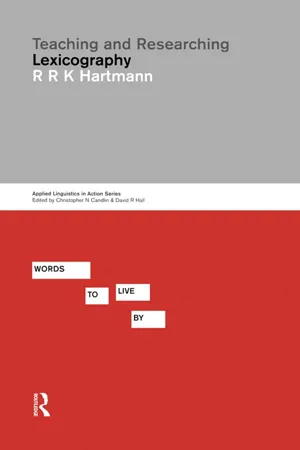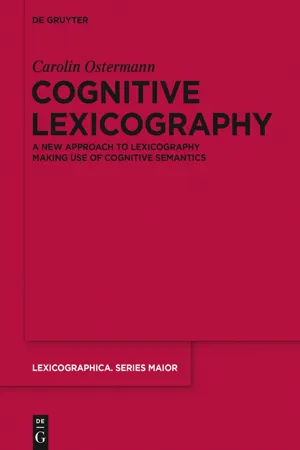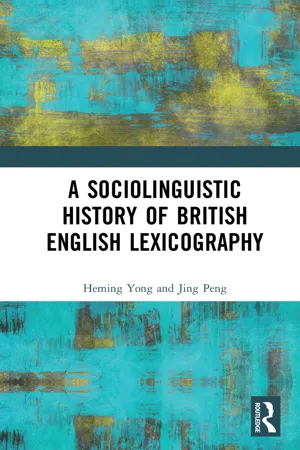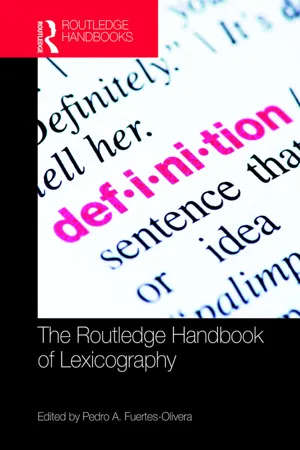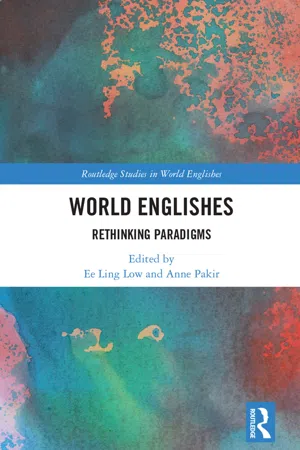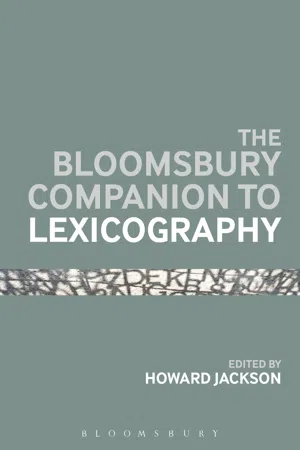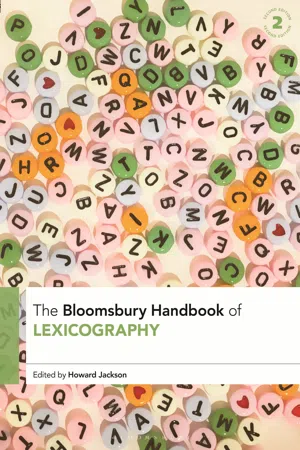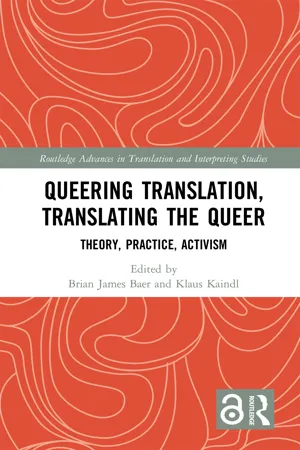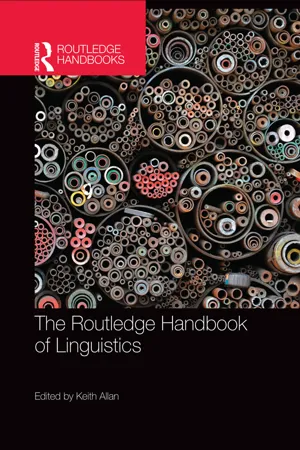Languages & Linguistics
Lexicography
Lexicography is the practice of compiling, writing, and editing dictionaries. It involves the study of words, their meanings, and usage within a language. Lexicographers use various sources to gather and analyze words, creating comprehensive and accurate records of a language's vocabulary.
Written by Perlego with AI-assistance
Related key terms
11 Key excerpts on "Lexicography"
- eBook - ePub
- Reinhard R.K. Hartmann(Author)
- 2016(Publication Date)
- Routledge(Publisher)
Section I Lexicography in practice and theoryPassage contains an image
Chapter 1 The lexicographic scene
DOI: 10.4324/9781315838922-1This chapter will...… dictionaries are a faithful reflection of the changing society that produces and consumes them.(Robert Ilson, 1990 : 1980)- describe the field of Lexicography;
- discuss Lexicography as a many-sided activity.
1.1 Mapping Lexicography
That dictionaries play an important part in our daily and academic lives is not in doubt. Most people could therefore say something sensible about them, give examples of one or two of them, and maybe even define them. However, things are not so obvious when it comes to ‘Lexicography’. If you ask academics, especially those who specialise in languages or linguistics, they would probably make a mental association between Lexicography and the dictionary, but would not be quite sure about the nature of that association. The study of dictionaries? The making of dictionaries? The history of dictionary making?What I want to do in this book is to ask some fundamental questions about what exactly these two notions are, where they come from and where they are going, how we can increase our understanding of their function(s) in the modern world, and what (inter-)disciplinary frameworks we need to find the answers.In addressing these questions, I will draw on my experience of building up a specialism at a particular university where the subject is both taught (at MA and PhD level) and investigated (in a Dictionary Research Centre). One of the first things our students realise is that dictionaries come in many different forms, and that they do not exist in a vacuum, but are produced and used in contexts which can vary considerably across space and over time. One of the first priorities they have to sort out is whether the Lexicography they are studying at university differs from the Lexicography - eBook - ePub
- Carolin Ostermann(Author)
- 2015(Publication Date)
- De Gruyter(Publisher)
3 Principles of learner Lexicography […] Lexicography is an activity which consists in observing, collecting, selecting, analysing and describing, […] a number of lexical items […] belonging to one or more languages. (Svensén 2009 : 2) This chapter seeks to outline lexicographic principles of monolingual Lexicography, especially those principles used in learner Lexicography. Since the Lexicography of English looks back on a rich tradition, many conventions regarding the set-up of a dictionary and the presentation of information within its entries have developed over this timespan, even if Wierzbicka (1985: 5), in her meanwhile famous quote, says that […] lexicographers are people who work hard but who can never escape having a guilty conscience, because Lexicography has no theoretical foundations, and even the best lexicographers, when pressed, can never explain what they are doing or why. The situation does not seem that desperate in practice; the lexicographic conventions regarding the dictionary’s form (concerning micro- and macrostructure, including problems such as homonymy and polysemy), the dictionary’s defining practice and further means of conveying meaning will briefly be outlined here. 19 All these conventions will later come into play again when the cognitive dictionary features are presented (regarding examples and macrostructure, definitions, or microstructure and polysemy, cf. chapters five to seven) and are therefore to be understood as the necessary basis from which cognitive lexicographic features depart, as the cognitive dictionary features are also designed within that framework. 20 The chapter will start with a delimitation of the genre of the monolingual learner’s dictionary and will be rounded off by a few remarks on the status of Lexicography as a craft lacking theory (cf - Heming Yong, Jing Peng(Authors)
- 2021(Publication Date)
- Routledge(Publisher)
General and specialized Lexicography From the perspective of research areas, Lexicography can be classified into general and specialized Lexicography. Just as general linguistics overarches all branches of linguistics, general Lexicography covers under its umbrella all branches of general Lexicography and conducts general studies in lexicographical histories, concepts, theories, models, principles and methodology respecting compilation and research. Its scope is not restrained by languages, types and perspectives that dictionaries involve. It should be noted that general and theoretical Lexicography overlap to some extent in scope of study, as they share some common issues.Representative works of general Lexicography include Sidney Landau’s Dictionaries: The Art and Craft of Lexicography (1989), Howard Jackson’s Lexicography: An Introduction (2002), Sven Tarp’s Lexicography in the Borderland Between Knowledge and Non-knowledge: General Lexicographical Theory With Particular Focus on Learner’s Lexicography (2008), Bo Svensén’s A Handbook of Lexicography: The Theory and Practice of Dictionary-making (2009) and so on. Specialized Lexicography is considered a major theoretical and practical component of general Lexicography and focuses on the theory and practice of special-subject dictionaries (i.e. dictionaries that engage specific subjects and fields) or special-aspect dictionaries (i.e. dictionaries that engage certain aspects of language). Representative works include Henning Bergenholtz and Sven Tarp’s Manual of Specialized Lexicography (1995), Fuertes-Olivera et al.’s Specialized Lexicography. The representation of meaning in business dictionaries (2008), Nuria Edo Marza’s Specialized Lexicographical Approach: A Step Further in Dictionary-making (2009) and so on.Monolingual and bilingual/multilingual Lexicography From the perspective of the number of languages involved, Lexicography can be classified into monolingual and bilingual/multilingual Lexicography. The former studies the historical development, typological classification, compiling principles, methodology and techniques as well as the pedagogical application of monolingual dictionaries, usually the native language dictionaries of compilers. The majority of existing monographs and articles fall into this category. Bilingual Lexicography studies the historical development, typological classification, compiling principles, methodology and techniques as well as the pedagogical application of bilingual dictionaries. Representative works include Doris A. Bartholomew and Louise C. Schoenhals’ Bilingual Dictionaries for Indigenous Languages (1983), Tadeusz Piotrowski’s Problems in Bilingual Lexicography (1994), Martin Stark’s Bilingual Thematic Dictionaries- eBook - ePub
- Pedro A. Fuertes-Olivera, Pedro A. Fuertes-Olivera(Authors)
- 2017(Publication Date)
- Routledge(Publisher)
Part IFoundations of Lexicography
Passage contains an image
1
Lexicography as an independent science
Sven Tarp1.1 Introduction
Lexicography is the discipline that deals with dictionaries and other reference works designed to be consulted in order to retrieve information. Although there is general agreement in the community about this short definition, much more controversial is the disciplinary status of Lexicography. This is not surprising in a discipline based on a millenary cultural practice which has created works of very different types and covering almost all spheres of human activity and thinking. Hence, if we take the two words included in the title of this contribution (i.e. independent and science), the different opinions on whether or not Lexicography can be regarded as independent (in relation to other disciplines) and a science can, roughly speaking, be divided into four big groups with no sharp dividing lines and much overlapping.Lexicographers belonging to the first group simply consider their discipline to be “art and craft” (Landau 2001). They do not only deny that Lexicography can be regarded as a science, they even reject the existence and possibility of lexicographical theories (Béjoint 2010). The only theories accepted are “an enormous body of linguistic theory which has the potential to help lexicographers to do their jobs more effectively” (Atkins and Rundell 2008: 4). In this understanding, the discipline is not independent but an “instance of applied linguistics” (Meier 2003: 307). At the outmost it can be considered a “scientific activity” if linguistics is “taken as a background” (Ten Hacken 2009: 399). This vision of Lexicography is especially strong in the Anglo-Saxon community.The second group characterizes Lexicography as a science. Kempcke (1984: 733), for instance, defines it as “the science of the arrangement and explanation of the vocabulary in dictionaries and lexica”. Similarly, Kudashev (2007: 159) regards it as “a branch of science which deals with presentation and description of lexical units of natural languages in the dictionaries”. In this vision, the science of Lexicography is understood, on the one hand, as a “special branch of linguistic science” (i.e. subordinated to linguistics) and, on the other hand, as “an independent discipline with its own theory, own tasks and own methods for their solution” (Sorokoletov 1982: 79). Scerba (1940) is the most renowned supporter of this vision of Lexicography which has its roots in Eastern Europe and part of Asia. - eBook - ePub
World Englishes
Rethinking Paradigms
- Ee Ling Low, Anne Pakir, Ee Ling Low, Anne Pakir(Authors)
- 2017(Publication Date)
- Routledge(Publisher)
11Lexicography and world EnglishesVincent Ooi11.1 Introduction
While the dictionary can be valorised for the codification and legitimacy of World Englishes (henceforth ‘WE’), central lexicographic issues concerning the linguistic treatment of WE lexicons remain: the exclusiveness of a variety label, definitional adequacy, and register labels illustrate some of these concerns. In this chapter, the discussion of such issues is grounded in an examination of lexical items that index their respective variety of English in well-known dictionaries of English. While these items are not deemed to be representative of the entire WE lexicographic enterprise, their examination invites an explanation for the inclusion/exclusion of potential lexical items in the WE dictionary and lexical principles are then suggested for improved codification of WE items in the future.A significant development in Lexicography nowadays is the increasing recognition of web or e(lectronic) Lexicography – as part of reference or information science – and the expected diminution of the print dictionary because of space and pragmatic constraints (see Rundell, 2015). Thus, a more inclusive definition of what Lexicography entails concerns “the use of reference and information tools dealing with ‘things’, ‘facts’, and ‘language’ related to the word”; that is, Lexicography is concerned with “the theory and practice of dictionaries, i.e., dictionaries, encyclopaedias, lexica, glossaries, vocabularies, terminological knowledge bases and other information tools covering areas of knowledge and its corresponding language” (Fuertes-Olivera, 2017). What we know as ‘the dictionary’ may now be expanded to any lexicographic tool that targets such information: richer and more varied types of word knowledge, types of user, quality of the evidence base (or ‘corpus’), and relevant contextual and world knowledge (see Ooi, 2017). Concomitantly, the term ‘world Englishes’ may be taken to refer to “all or any of the varieties spoken around the world, including British English, and, of course, forms such as Nigerian, Malaysian, or New Zealand English”, with a perspective “usually a national one” (Schneider, 2011, p. 29). - Pedro A. Fuertes-Olivera, Sven Tarp(Authors)
- 2014(Publication Date)
- De Gruyter(Publisher)
The artificial separation of these theories, methods and forms of presentation into lexicographical and terminographical (terminological) has no relevance or scientific basis when their final products are considered, from the point of view of the foreseen users, to be utility products designed to satisfy their different information needs. They all fall into the broad category of specialised dictionaries or lexicographical works, as they are defined by the function theory. Consequently, terminography – that is, the production of reference works based upon terminological principles – is here understood as an integrated part of specialised Lexicography, whereas terminology – like LSP research – is taken as a discipline with which specialised Lexicography interacts in the conception and production of a number of specific reference works.3.4 Relation to information science
Information science came into the world as an independent discipline in the first half of the twentieth century and has undergone an enormous upsurge during the last decades due, among other things, to the rapid development of the corresponding technologies. By comparison, Lexicography, as a four thousand year-old cultural practice, has inevitably brought forth a large accompanying literature of academic reflections, but it is not until the twentieth century that the discipline has been subject to a systematic theory building, that is, more or less during the same period in which information science was founded and flourished. Until recently, the two disciplines have developed along parallel lines albeit with no or very few formal relation between them. However, with the growing focus on information in society and the incorporation of the new technologies into lexicographical practice, it has become increasingly clear that Lexicography has a lot in common with information science, especially the part of it concerned with information organisation and retrieval.As a result, it is appropriate to emphasize that when an abstraction is made from the concrete and specific content of the needs lexicographical works have attempted to meet during the millennia, what is left is their common nature of information needs in the true sense of the word. Essentially, the users of these works always look for and, if they are successful, retrieve information- eBook - ePub
- Howard Jackson, Howard Jackson(Authors)
- 2013(Publication Date)
- Bloomsbury Academic(Publisher)
Wörterbücher/Dictionaries/Dictionnaires (Hausmann et al. 1989–91).From the 1990s on Lexicography has been an established academic subject in a number of universities, for example Aarhus (Denmark), Barcelona (Spain), Birmingham (UK), Cergy-Pontoise (France), Göteborg (Sweden), Lille (France) and Poznań (Poland) (also see Hartmann, this volume). In about half a century dictionaries and Lexicography have become a mature field of scientific endeavour, having its own traditions and institutions (also see Gouws 2004).2 Research in LexicographyAs may already be clear from the titles of some of the handbooks quoted above, the exact content of what is covered by the term lexicographic research is not always the same: for one author Lexicography is essentially a craft or even an art, whereas others insist on the necessity of a sound scientific basis for dictionaries. Reading through the relevant literature makes it clear also that the points of view taken and the types of dictionaries studied may vary substantially. Zgusta (1971), for instance, starts with the discussion of a number of linguistic (semantic, morphological, combinatorial and stylistic) aspects which cover more than half of his book. Dubois and Dubois (1971), on the other hand, present dictionaries, monolingual as well as bilingual ones, language dictionaries as well as encyclopedic dictionaries, as pedagogic texts at the service of an intended group of users, devoting only limited space to some semantic and stylistic issues. Rey-Debove (1971) defines the dictionary as ‘a work that describes a language through a lexical approach’, paying no attention to the user nor to bilingual or encyclopedic dictionaries. - eBook - ePub
- Howard Jackson, Howard Jackson(Authors)
- 2022(Publication Date)
- Bloomsbury Academic(Publisher)
Wörterbücher/Dictionaries/Dictionnaires (Hausmann et al. 1989–91).From the 1990s on Lexicography has been an established academic subject in a number of universities, e.g. Aarhus (Denmark), Barcelona (Spain), Birmingham (UK), Cergy-Pontoise (France), Göteborg (Sweden), Lille (France) and Poznań (Poland) (see also Hartmann, Chapter 25 ). In about half a century dictionaries and Lexicography have become a mature field of scientific endeavour, having its own traditions and institutions (see also Gouws 2004).2 Research in LexicographyAs may already be clear from the titles of some of the handbooks quoted above, the exact content of what is covered by the term ‘lexicographic research’ is not always the same: for one author Lexicography is essentially a craft or even an art, whereas others insist on the necessity of a sound scientific basis for dictionaries. Reading through the relevant literature makes it clear also that the points of view taken and the types of dictionaries studied may vary substantially. Zgusta (1971), for instance, starts with the discussion of a number of linguistic (semantic, morphological, combinatorial and stylistic) aspects which cover more than half of his book. Dubois and Dubois (1971), on the other hand, present dictionaries, monolingual as well as bilingual ones, language dictionaries as well as encyclopaedic dictionaries, as pedagogic texts at the service of an intended group of users, devoting only limited space to some semantic and stylistic issues. Rey-Debove (1971) defines the dictionary as ‘a work that describes a language through a lexical approach’, paying no attention to the user nor to bilingual or encyclopaedic dictionaries. - eBook - ePub
- Constantine R. Campbell(Author)
- 2015(Publication Date)
- Zondervan Academic(Publisher)
one of its possible senses.A key way to determine the meaning of a word in context is to compare and contrast the sense of the word with other words with related senses. 3.3 New Testament Greek LexicographyHaving discussed some of the key methodological issues of lexical semantics, we turn now to the application of theory as it relates to New Testament Greek. Lexicography is the study of words with a view to their collection in a dictionary. While the New Testament is the corpus we are interested in, the language of the New Testament should not be understood apart from its historical context. That is, the New Testament employs language that is naturally found in the first century, and in that sense our interest in this corpus is artificial. “New Testament Greek” is no different from the Greek used throughout the Koine period (see §1.3.1), and thus any practice of Lexicography must take into account the use of words outside the New Testament as well as their use within it. This means that “New Testament Greek Lexicography” is the study of words that appear in the New Testament, without claiming that there is something special about the language of the New Testament. It may be special to us because it is in the New Testament, but it is not special from a linguistic point of view.3.3.1 Difficulties in PracticeNew Testament Greek Lexicography is a difficult and arduous task. First, the practice of understanding words in context is complex and involves careful study of each word as it appears in ancient literature. This task alone can take a lifetime. Second, whenever advances in lexical semantics occur, the task of Lexicography is altered. This means that lexicographers are required to update their methods and nuance their results according to the best theoretical advances. It also means that previous results may need adjustment or correction. Third, the language of the New Testament is overlaid with special challenges — not because the language itself is any different from standard first-century Greek, but because of the nature of the New Testament. This corpus has a history of interpretation spanning two thousand years, which will affect the way we read it. There are a myriad of theological issues that play into how we understand the language. Furthermore, new evidence is coming to light even now that requires to be factored in to our conclusions. As the great New Testament lexicographer Frederick Danker once said, “Change spells pain, but . . . scholars’ tasks are ‘not for sissies.’ ”25 - eBook - ePub
Queering Translation, Translating the Queer
Theory, Practice, Activism
- Brian James Baer, Klaus Kaindl, Brian James Baer, Klaus Kaindl(Authors)
- 2017(Publication Date)
- Routledge(Publisher)
As we have seen, a dictionary is not an objective source of knowledge but rather the product of a series of biased decisions by the lexicographers. Those decisions, however, are not made in a void but are subject to a broad range of external influences, ranging from precise, explicit norms, such as grammar rules, to more general, implicit, and even unconscious socio-cultural norms related to heteronormativity. Both in mono- and interlingual dictionaries, the lexicographers determine meanings, set them in relation, and recommend or exclude words and phrases from use, either by eliminating them from the lemmary or by assigning them connotational markers that discourage their usage in many communicative circumstances. Interlingual dictionaries suffer from the urge to produce translation equivalents. Even though full equivalence is impossible in the majority of cases, lexicographers often tend to suggest "synonymical" translations, even if only partially reflecting the meaning, running the risk that these will be perceived as full equivalents (which they often are by students of the language).That being said, the lexicographer can still exercise a certain degree of agency. This agency can be found at various levels of dictionary making, thus influencing the final outcome, the dictionary itself. A diachronic analysis, for example, can challenge the naturalness of the dominant discourse by showing how meaning definitions change over time. Because the activity of dictionary making is not innocent, there is a need for greater awareness on the part of translators and users in general of the effects of the lexicographer's decision making. The lexicographer is not less a "harmless drudge" but a powerful (re-)producer of linguistic, cultural, and social power structures.Queer(ing) Lexicography contributes to detecting structures of power and of heteronormative discourses in order to make them visible and raise awareness of their existence, a necessary first step in challenging them. The fact that the dictionary represents such a highly influential work with the power to reinforce and strengthen heteronormative discourses, but also to weaken and dismantle them makes this an especially urgent task. - eBook - ePub
- Keith Allan, Keith Allan(Authors)
- 2015(Publication Date)
- Routledge(Publisher)
They demonstrated the utility of the dictionary’s alphabetical construction in accessing general and/or specialized words of the language – hence its widespread use in the titles of reference books of itemized information in any field of knowledge, e.g. Dictionary of Dreams, Dictionary of Sport and Exercise Science. For thesauruses there is no conventional set of conceptual structures. Their construction varies with the publication, though each is designed as a means of accessing the common lexicon, to help those reaching for words lost from short-term memory, or wanting to explore sets with similar or related meanings. Yet thesaurus structures do not seem to be as intuitive as their authors intended, and most thesauruses provide an alphabetical index as a key to their internal construction (see §12.3.3). This chapter traces the development and increasing convergence of dictionaries and thesauruses in English since the early modern era. From their different practical and theoretical starting points, both have evolved in structure and content in response to the pedagogical and socio-cultural needs of the times. Commercial imperatives have no doubt always impacted on their construction, as well as recent quantum leaps in information technology. Whether Lexicography can be said to have developed a body of theory is an open question (Wierzbicka 1985), amid debate about its independence as a discipline. Lexicographers divide over its debt to lexicology and (applied) linguistics, though both theorists and practitioners agree on the importance of foregrounding the dictionary’s functions and users (Bergenholz and Tarp 2003; Rundell 2012). Some suggest it would be more appropriate to speak of the science of Lexicography (Bogaards 2010), now that the body of empirical research on dictionary use has been effectively indexed (Welker 2010)
Index pages curate the most relevant extracts from our library of academic textbooks. They’ve been created using an in-house natural language model (NLM), each adding context and meaning to key research topics.
